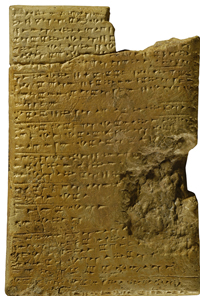- Introduction
- Index
- Further information

The so-called "Ugaritic" writing is the local writing of the ancient city of Ugarit (modern Ras Shamra). It consists of a cuneiform alphabet (better: abjad) made up of 30 consonantal signs (the "long" alphabet). We have evidence of this writing nearly exclusively in the city of Ugarit or in the nearby Ras Ibn Hani, summer residence of the kings of Ugarit. The documentation can be roughly dated from 14th century BC until the beginning of 12th century BC. Ugaritic writing was most probably invented locally, adapting an already existing alphabetic writing system to the cuneiform one characteristic for the Akkadian language which was at that time used as a lingua franca through the Ancient Near East.
Various cuneiform tablets unearthed at Ugarit allow us to define exactly the order of the alphabetic signs (cf. Sign list); the Ugaritic alphabetic signs are more or less arranged in the same order of the later Phoenician alphabet.
To this widely attested alphabet are to be added two other writing systems which are only rarely documented in the city of Ugarit. A "short" cuneiform alphabet, made up of only 22 signs, and another cuneiform "long" alphabet with a different arrangement of the letter order (namely with characteristic South Arabian letter sequence h, l ḥ, m) found in only one abecedary (RS 88.2215, cfr. P. Bordreuil, D. Pardee, RSO 14, 2001, 341-348).
Go to the online resources.
Online resourcesIndex
Evidence and spread
The excavations in Ugarit (Ras Shamra) unearthed nearly 2000 texts and fragments written in the Ugaritic language as well as some other documents written in different writings and languages in use at that time (14th – beginning of 12th cent BC). Some bilingual and plurilingual texts are very important for their lexicographical and grammatical value. In most cases, they consist of lists written in parallel columns in different languages: Sumerian and Akkadian, sometimes with the addition of an Ugaritic column and (rarely) also Hurrian.
Most of the Ugaritic texts are administrative (contracts and lists), in minor quantity also literary texts (mythological and religious), letters, school (exercises, alphabets) and juridical texts.
Nearly all texts in the Ugaritic language come from Ugarit or Ras Ibn Hani, situated ca. 3 miles southeast from Ugarit. Only a very small number of other Ugaritic tablets has been found outside the reign of Ugarit, namely in some archaeological sites in Syria, Libanon and modern Israel (Tell Sukas, Kamid el-Loz, Sarepta, Tell Taanak, Nahal Tavor, Beth-Shemesh).
Formal characters of the writing and the two alphabets
The Ugaritic writing is cuneiform (the signs are wedges inscribed in clay) like Akkadian, but its linguistic principle is completely different from the Akkadian syllabic-logographic writing system: Rather than represent syllables (as in Akkadian), Ugaritic writing represents every single consonant. The Ugaritic is therefore an alphabetic writing type (better: abjad) where each consonant has a separate symbol. Only the consonant alif (the glottal stop) appears in a triple form: depending on the following vowel: { } for /ˀa/; {
} for /ˀa/; { } for /ˀi/, /ˀê/ or /Voc.+ ˀ/; {
} for /ˀi/, /ˀê/ or /Voc.+ ˀ/; { } for /ˀu/ and /ˀô/.
} for /ˀu/ and /ˀô/.
The Ugaritic abecedary tablets unearthed until now (at present more than ten tablets) show a strong consistency of the letter sequence (cf. sign list); this sequence is very similar to the letter order found in Phoenician and in the other Semitic languages of the 1st millennium BC. This evidence points out how wide spread the same scribal tradition was. Only a single abecedary tablet shows a different arrangement of the consonant order (namely the sequence h, l ḥ, m) typical of the Southern Semitic languages (RS 88.2215).
The abecedary tablet KTU 5.14, unfortunately fragmentary, is of utmost importance. In this tablet every Ugaritic consonant is “translated” into an Akkadian syllabic sign which should render its pronunciation.
A few texts written in variants of the “short” Ugaritic cuneiform alphabet (with only 22 consonants) have been discovered in some Syrian-Palestinian sites and in Cyprus. Most of the consonantal signs are identical to the ones from the “long” alphabet, even if some graphemes have different forms.
Writing arrangement
Ugaritic scribes used to write the tablets horizontally, starting at the top left corner of the tablet, proceeding from left to right and placing the new line under the previous one.
Most Ugaritic texts use a small vertical wedge as a word separator (usually transcribed with a full stop).
Photo Gallery
List of symbols
Examples of writing
Bibliography
Map of places
